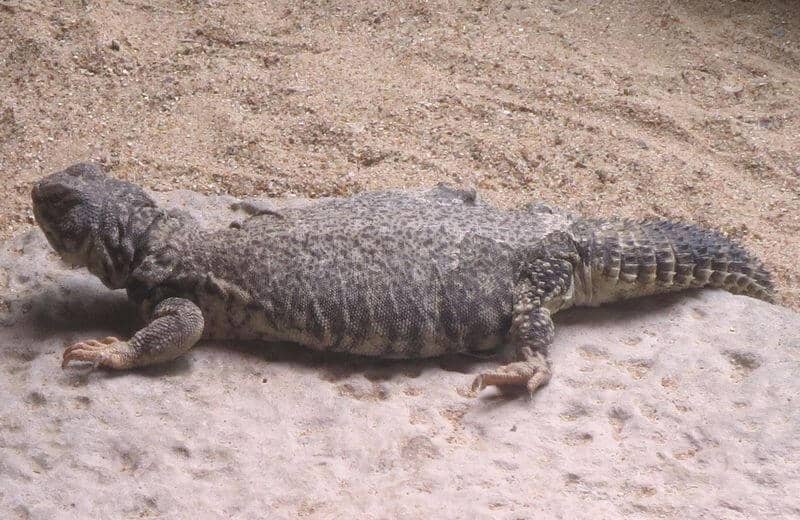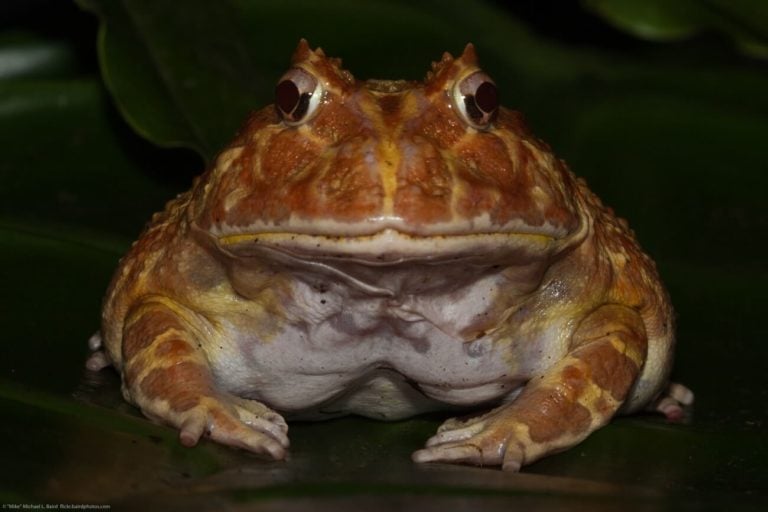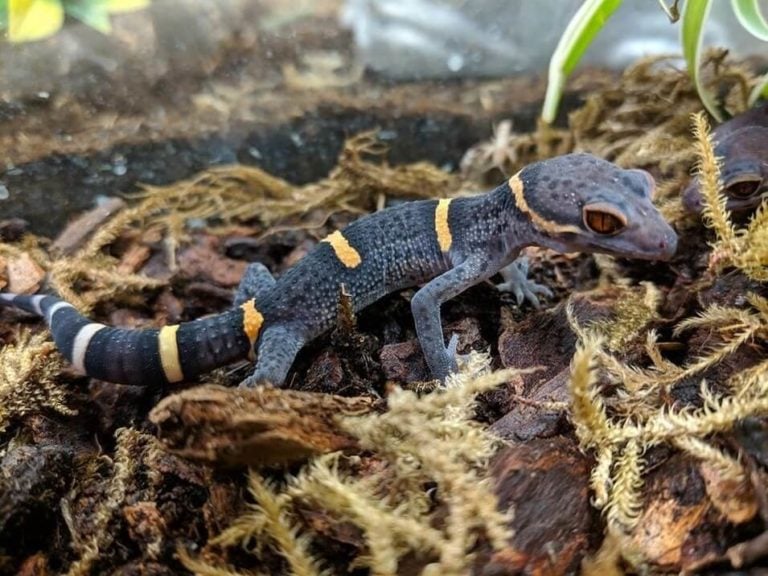The Mali uromastyx is an interesting species that appeals to many different reptile-lovers. There really isn’t anything like them!
This care guide will teach you everything you need to know about keeping Mali uromastyx. We cover their size, lifespan, diet, enclosure setup, and plenty of other helpful information.
Table of Contents
Species Summary
The Mali uromastyx (Uromastyx maliensis) is a moderately sized lizard popular among herpetology buffs. This reptile is native to the arid deserts of Africa. More specifically, this species comes from the deserts of Mali, hence its namesake.
In many parts of the world, the Mali uromastyx is nothing more than a pet lizard. But to the people of Mali, the lizard is considered a culinary delicacy. It goes by many names. Locally, it’s known as the “drab lizard” or “spiny-tailed Agama.”
Revered for its stocky build and generally easy-going personality, the Mali uromastyx can be a joy to raise. However, it does have specific care requirements. Thanks to their large size, these lizards require spacious habitats that are well-maintained with pristine environmental conditions.
Appearance & Colors
This reptile is a thing of beauty. While many unique lizard species exist in the pet trade, the Mali uromastyx certainly stands out.
Let’s start with their body shape. Mali uromastyx is a medium-to-large lizard with a girthy build. Like other desert-dwelling lizards, this species has strong legs and five fingers.
Their fingers and toes have small claws, and the lizard uses their hands to get around the rough terrain.
Many Mali uromastyx can develop large bellies. That’s especially true when living in captivity. But even “slim” lizards have stocky bodies.
The head is round. Ridges above the eyes provide additional protection. Meanwhile, the snout has a modest point.

The most interesting physical detail of the Mali uromastyx is its tail. The tail is thick and stocky. Its size can mirror that of the lizard’s core.
The lizard’s tail is highly flexible and takes on a spiky appearance. On some Mali uromastyx, the spikes are so well-defined that they look like vertebrae! These reptiles use the tail in many ways, including for aggressive behavior and protection.
For color, there’s some variety in the Mali uromastyx species.
As juveniles, most lizards are predominantly gray. They typically have charcoal-colored spots that create the perfect camouflage young lizards need to reach adulthood.
Females can maintain that color as they mature, but most Mali uromastyx will develop newer colors as they age.
Males typically take on a dark black color. Yellow patterns develop on the back and belly, giving the mature lizard a distinct look. The arrangement of yellow and black can vary.
For some lizards, they appear as simple freckles. For others, it’s hollow eye shapes, honeycomb shapes, or tiger stripes.
Females are more muted, taking on a mix of light and dark brown.
Average Mali Uromastyx Size
These lizards are considerably larger than common geckos or anoles. The size of a mature Mali uromastyx can reach lengths up to 16 inches from its snout to the tip of its tail.
Expert Tip: Males are slightly larger than females. The male lizards are usually 15 to 16 inches long, tipping the scales at around 15 ounces. Meanwhile, females usually average 10 to 14 inches long and weigh only 12 ounces.
Lifespan
If you plan on bringing one of these lizards home, you must be prepared for many years of care. The Mali uromastyx has a lifespan of up to two decades in captivity. Fifteen to 20 years is the average for this species.
That said, there are no guarantees. Like any other pet, Mali uromastyx can suffer from genetic conditions and health problems that shorten its lifespan (more on that later).
The best thing you can do is provide the best care possible to keep your lizard healthy and optimize its life expectancy.
Mali Uromastyx Care
Mali uromastyx care is not particularly difficult. However, their larger size and habit requirements can challenge less experienced reptile keepers. This species has many requirements in order to stay in good health and enjoy a high quality of life.
Here’s what you need to know if you want to properly care for a Mali uromastyx.
Enclosure Size
You can stick with a smaller terrarium if you have a younger Mali uromastyx. Typically, 30-gallon enclosures are fine for a growing juvenile.
However, you’ll need to upgrade as your lizard reaches maturity.
Reptile experts recommend keeping adult Mali uromastyx lizards in a habitat that measures no smaller than 36 inches long, 18 inches wide, and 18 inches tall. You can find 50-gallon terrariums with those dimensions.
That’s the bare minimum to accommodate this lizard’s size. A 50-gallon terrarium will comfortably house a single adult Mali uromastyx. However, it’s always better to go bigger.
A terrarium that’s 48 inches long, 24 inches wide, and 18 inches tall is ideal if you have the space to accommodate a habitat of that size. A slightly bigger enclosure will improve the reptile’s quality of life and provide more room for you to create the perfect environment.
Habitat Setup
Like any other reptile, the best approach when establishing an indoor habitat for a Mali uromastyx is to replicate its natural environment. In this situation, your inspiration is the arid deserts of Mali.
Starting with the substrate, the best material for this species is a sand and soil mix. Choose reptile-safe sand and soil, mixing the two mediums with a 1:1 ratio.
In the wild, the Mali uromastyx is a burrower. These reptiles burrow in the substrate to regulate their body temperature and stay cool.
While you can use substrates like reptile carpet or newspaper, it’s best to use soil for long-term housing. Create a layer that’s at least three inches thick.
If you don’t want to use sand and soil, you can use aspen chips.
Next, you can add rocks. Add a nice mix of large and medium-sized rocks throughout the enclosure. They should sit directly on the bottom of the terrarium. Placing them on top of the substrate could lead to accidental injury when your lizard burrows.
Avoid using small rocks. These reptiles have a knack for swallowing items that aren’t food, so you want to avoid anything that they could fit into their mouths.
In addition to rocks, add a few fake plants. They don’t have to be huge. A few short plants are all your lizard needs for shade.
You can also add a few pieces of wood or branches. Secure these decorations to the terrarium glass. Your lizard may use them for climbing.
Finally, add a hide box. If you have a larger enclosure, add two hide boxes on opposite sides of the habitat. They should be big enough for your lizard to fit into comfortably.
Temperature & Lighting
Hot and dry conditions are what the Mali uromastyx needs to thrive!
These reptiles are cold-blooded and need to move around to thermoregulate. When creating a lighting rig, you must establish a temperature gradient.
On one side of the tank, install a basking light. These lizards love to bask in the sun, so you must accommodate that behavior in captivity.
Install the basking lamp in one corner of the enclosure outside the confines of the habitat. It should bring the temperature in that one spot up to about 120 degrees Fahrenheit.
The surrounding areas should be around 100 degrees. Meanwhile, the cooler end should be a stable 80 to 85 degrees during the day.
At night, temperatures can fall as low as 70 degrees. But if it gets cooler, install heat emitters and under-tank heating pads.
Invest in a reliable digital thermometer. You must monitor conditions and keep things stable.
Your lighting rig should be on a 12-hour timer. These lizards need 12 hours of light and 12 hours of dark. The Mali uromastyx is diurnal but needs darkness to keep its circadian rhythm in check.
In addition to your standard lighting rig, you’ll need UVB lights. UVB light is essential for this species. Without it, they can’t synthesize calcium and may develop metabolic bone disease.
Use your UVB lights throughout the day. Set them on a timer alongside your standard lights, and remember to swap out the bulb every six months.
Humidity
Comparatively, the Mali uromastyx needs lower humidity levels than other reptile species. They come from the desert, so the tropical conditions of other lizards won’t cut it for the Mali uromastyx.
Install a hygrometer to keep watch of humidity levels in the enclosure. The relative humidity needs to be between 10 and 25 percent.
If the humidity gets too high, you can open vents in the terrarium to promote air circulation and evaporation.
If the humidity gets too low, your lizard may start to shed excessively. To avoid that, you can mist the enclosure daily to get things right.
Check the humidity levels regularly and make adjustments as necessary. Stability is key.
Water
Some reptile keepers say you should include a water dish, but this is strictly optional for the Mali uromastyx.
This species lives in a desert environment with little access to water. It gets hydration from the food it eats.
If you choose to install a water dish, don’t be surprised if you don’t see your lizard drinking from it. Typically, the lizard will use the water dish for soaking more than anything else.
Food & Diet
The Mali uromastyx is an herbivore that largely survives on shrubbery in the wild. In captivity, they do best on a mainly plant-based diet.
Here are some great foods that your Mali uromastyx can eat:
- Peas
- Collard greens
- Mustard greens
- Kale
- Romaine lettuce
- Beet greens
- Carrot top greens
- Turnip greens
- Carrots
- Squash
- Green beans
- Bird seed
Expert Tip: Young juveniles will need to eat every day. Mature Mali uromastyx can eat about four or five times per week.
How much you provide depends on your lizard’s appetite. Some lizards will eat small portions more often, while others prefer larger meals spaced out. You’ll have to monitor your lizard and see what it prefers.
When you provide those plant-based foods, dust them with calcium and multivitamin supplements. You should dust everything growing Mali uromastyx lizards eat. But for adults, dust the food a few times per week.
You can provide the occasional cricket or mealworm. However, protein-based foods should be nothing more than a snack. Mali uromastyx can’t process tons of protein, so providing too many insects could lead to health problems.
Potential Health Issues
The most common health concern for this species is metabolic bone disease. This condition occurs when the lizard doesn’t get enough Vitamin D3 from UVB exposure. The bones can become brittle, leading to deformities and frequent fractures.
Fortunately, it’s avoidable. Install a UVB lamp and dust your lizard’s food with calcium regularly.
Another health concern to be wary of is parasites. Parasitic infections can cause dramatic weight loss. You may also notice lethargy and bloody stools.
Take your lizard to a vet who specializes in exotic animals for treatment.
Finally, Mali uromastyx can suffer from infections. One of the most common is tail rot. However, these lizards can also experience respiratory infections.
In most cases, infections are a byproduct of poor tank maintenance and improper conditions. More specifically, excessive humidity is to blame.
Keep watch over the temperature and humidity levels. Keep them stable and within the comfortable range.
To keep bacteria at bay, spot-clean the enclosure daily. Then, replace the substrate about once per month. You should remove everything from the habitat every three months and clean it with a reptile-safe sanitizing product.
Behavior & Temperament
For the most part, Mali uromastyx is a relaxed species that’s easy to care for and own. The lizards do well in captivity and can form great bonds with humans.
However, they will experience issues if you attempt to house more than one Mali uromastyx together. Males get territorial and aggressive. They can also become problematic when housed with females due to their constant quest for breeding.
Because of this, it’s best to keep these lizards alone. They do fine in solitude. With regular exposure and interaction, they develop a calm temperament and will rarely show signs of aggression.
If a Mali uromastyx is unhappy, you’ll know it! The lizard will hiss and flick its spiked tail around. Learn to read your lizard’s body language to avoid accidental bites.
Handling Them
Handling a Mali uromastyx is easy, and this species does well with human interaction. However, you must build trust over time in order to do this.
Younger Mali uromastyx lizards can get comfortable quickly with human interaction. You can provide food directly to your lizard with your hands to build trust and establish a bond.
Once your lizard gets comfortable and shows no signs of stress or discomfort, you can handle them.
Lift the body gently and place the lizard on your hand. Allow it to get comfortable and avoid any sudden movements or noises.
Start handling for small periods. You can work your way up gradually as the lizard becomes more comfortable.
Closing Thoughts
Mali uromastyx care isn’t hard as long as you’re willing and able to provide them with the appropriate habitat and enclosure. So if that sounds like you, don’t be afraid to give this species a chance!
We’d love to hear from you with any questions or stories about your experience with these reptiles. Don’t be shy!


